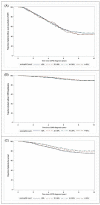Blood eosinophilia, use of inhaled corticosteroids, and risk of COPD exacerbations and mortality
- PMID: 30264901
- PMCID: PMC6282838
- DOI: 10.1002/pds.4655
Blood eosinophilia, use of inhaled corticosteroids, and risk of COPD exacerbations and mortality
Abstract
Purpose: It remains unclear whether eosinophilia is useful for in guiding inhaled corticosteroid (ICS) therapy in chronic obstructive pulmonary disease (COPD) patients. The goal of this study is to evaluate the risk of acute exacerbations, COPD-related hospitalisations/accident and emergency visits, and all-cause mortality with various levels of eosinophil counts among COPD patients using ICS.
Methods: A cohort study was conducted using the UK Clinical Practice Research Datalink. Patients were aged 40+ and had COPD (n = 32 693). Current users of ICS were stratified by relative and absolute eosinophil counts to determine the risk of outcomes with blood eosiniphilia using Cox regression analysis.
Results: Among COPD patients, current use of ICS was not associated with a reduced risk of acute COPD exacerbations, COPD-related hospitalisations/accident and emergency visits, and all-cause mortality. Stratification of ICS use by absolute or relative eosinophil counts did not result in significant differences in risk of COPD exacerbations or hospitalisations/accident and emergency visits. However, all-cause mortality was reduced by 12% to 24% among patients with eosinophilia.
Conclusions: COPD-related acute exacerbations or hospitalisations/accident and emergency visits were not reduced with eosinophilia among users of ICS with COPD. However, all-cause mortality was reduced by 12% to 24%. These findings are potentially important and require further evaluation in prospective studies.
Keywords: chronic obstructive pulmonary disease; eosinophils; exacerbations; inhaled corticosteroids; pharmacoepidemiology.
© 2018 The Authors. Pharmacoepidemiology & Drug Safety Published by John Wiley & Sons Ltd.
Figures


Similar articles
-
Blood Eosinophil Counts, Withdrawal of Inhaled Corticosteroids and Risk of COPD Exacerbations and Mortality in the Clinical Practice Research Datalink (CPRD).COPD. 2019 Apr;16(2):152-159. doi: 10.1080/15412555.2019.1608172. Epub 2019 May 23. COPD. 2019. PMID: 31117850
-
Eosinophil counts in first COPD hospitalizations: a comparison of health service utilization.Int J Chron Obstruct Pulmon Dis. 2018 Oct 1;13:3045-3054. doi: 10.2147/COPD.S170743. eCollection 2018. Int J Chron Obstruct Pulmon Dis. 2018. PMID: 30319252 Free PMC article.
-
Comparative effectiveness of LABA-ICS versus LAMA as initial treatment in COPD targeted by blood eosinophils: a population-based cohort study.Lancet Respir Med. 2018 Nov;6(11):855-862. doi: 10.1016/S2213-2600(18)30368-0. Epub 2018 Oct 18. Lancet Respir Med. 2018. PMID: 30343028 Clinical Trial.
-
Absolute Blood Eosinophil Counts to Guide Inhaled Corticosteroids Therapy Among Patients with COPD: Systematic Review and Meta-analysis.Curr Drug Targets. 2019;20(16):1670-1679. doi: 10.2174/1389450120666190808141625. Curr Drug Targets. 2019. PMID: 31393244
-
Blood eosinophil count, a marker of inhaled corticosteroid effectiveness in preventing COPD exacerbations in post-hoc RCT and observational studies: systematic review and meta-analysis.Respir Res. 2020 Jan 3;21(1):3. doi: 10.1186/s12931-019-1268-7. Respir Res. 2020. PMID: 31900184 Free PMC article.
Cited by
-
Individual trajectory-based care for COPD: getting closer, but not there yet.ERJ Open Res. 2021 Dec 13;7(4):00451-2021. doi: 10.1183/23120541.00451-2021. eCollection 2021 Oct. ERJ Open Res. 2021. PMID: 34912881 Free PMC article. Review.
-
High blood eosinophils predict the risk of COPD exacerbation: A systematic review and meta-analysis.PLoS One. 2024 Oct 3;19(10):e0302318. doi: 10.1371/journal.pone.0302318. eCollection 2024. PLoS One. 2024. PMID: 39361621 Free PMC article.
-
Elevated Peripheral Blood Eosinophils during Acute Exacerbation of Chronic Obstructive Pulmonary Disease: Prevalence and clinical significance.Sultan Qaboos Univ Med J. 2022 Aug;22(3):339-342. doi: 10.18295/squmj.8.2021.099. Epub 2022 Aug 25. Sultan Qaboos Univ Med J. 2022. PMID: 36072062 Free PMC article.
-
Neutrophil-to-lymphocyte ratio, blood eosinophils and COPD exacerbations: a cohort study.ERJ Open Res. 2021 Dec 27;7(4):00471-2021. doi: 10.1183/23120541.00471-2021. eCollection 2021 Oct. ERJ Open Res. 2021. PMID: 34988219 Free PMC article.
-
Clinical Predictors of High Blood Eosinophils in Chronic Obstructive Pulmonary Disease.Int J Chron Obstruct Pulmon Dis. 2021 Aug 28;16:2467-2474. doi: 10.2147/COPD.S324511. eCollection 2021. Int J Chron Obstruct Pulmon Dis. 2021. PMID: 34483658 Free PMC article.
References
-
- Vogelmeier CF, Criner GJ, Martinez FJ, et al. Global strategy for the diagnosis, management, and prevention of chronic obstructive lung disease 2017 report. GOLD executive summary. Am J Respir Crit Care Med [Internet]. 2017;195(5):557‐582. Available from: doi: 10.1164/rccm.201701-0218PP - DOI - PubMed
-
- Calverley PMA, Anderson JA, Celli B, et al. Salmeterol and fluticasone propionate and survival in chronic obstructive pulmonary disease. N Engl J Med [internet]. 2007;356(8):775‐789. Available from: http://www.ncbi.nlm.nih.gov/26641631/17314337 - PubMed
-
- Vedel‐Krogh S, Nielsen SF, Lange P, Vestbo J, Nordestgaard BG. Blood eosinophils and exacerbations in COPD: the Copenhagen General Population Study. Am J Respir Crit Care Med [Internet]. 2015;rccm.201509‐1869OC. Available from: http://www.atsjournals.org/doi/10.1164/rccm.201509-1869OCn http://www.ncbi.nlm.nih.gov/26585525/26641631 - DOI - PubMed
MeSH terms
Substances
LinkOut - more resources
Full Text Sources
Other Literature Sources
Medical

